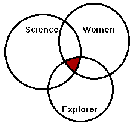 Probing Questions take us below the surface to the "heart of the matter." They operate somewhat like the archeologist's tools - the brushes which clear away the surface dust and the knives which cut through the accumulated grime and debris to reveal the outlines and ridges of some treasure. Another appropriate metaphor might be exploratory surgery. The good doctor spends little time on the surface, knowing full well that the vital organs reside at a deeper level. Probing Questions take us below the surface to the "heart of the matter." They operate somewhat like the archeologist's tools - the brushes which clear away the surface dust and the knives which cut through the accumulated grime and debris to reveal the outlines and ridges of some treasure. Another appropriate metaphor might be exploratory surgery. The good doctor spends little time on the surface, knowing full well that the vital organs reside at a deeper level.
We never stop investigating. We are never satisfied that we know enough to get by. Every question we answer leads on to another question. This has become the greatest survival trick of our species.
Desmond Morris, The Naked Ape, ch. 5 (1967).
The search for insight involves some of the same exploratory elements. In an earlier issue of From Now On (January, 1997), I wrote at some length about the search for "convergence" which guides oil prospecting. The geologist knows that the odds of finding oil are greatly increased when three or four elements are all present in the same location.
When it comes to information-seeking, the convergence is  established by creating a logical intersection of search words and key concepts, the combination of which is most likely to identify relevant sites and articles. Probing Questions allow us to push search strategies well beyond the broad topical search to something far more pointed and powerful. established by creating a logical intersection of search words and key concepts, the combination of which is most likely to identify relevant sites and articles. Probing Questions allow us to push search strategies well beyond the broad topical search to something far more pointed and powerful.
And when we first encounter an information "site," we rarely find the treasures lying out in the open within easy reach. We may need to "feel for the vein" much as the lab technician tests before drawing blood. This "feeling" is part logic, part prior knowledge, part intuition and part trial-and-error.
Logic - We check to see if there is any structure to the way the information is organized and displayed, if there are any sign posts or clues pointing to where the best information resides. We assume the author had some plan or design to guide placement of information and we try to identify its outlines.
Prior Knowledge - We apply what we have seen and known in the past to guide our search. We consider information about the topic and prior experience with information sites. This prior knowledge helps us to avoid dead ends and blind alleys. It helps us to make wise choices when browsing through lists of "hits." Prior knowledge also makes it easier to interpret new findings, to place them into a context and distinguish between "fool's gold" and the real thing.
Intuition - We explore our hunches, follow our instincts, look for patterns and connections, and make those leaps our minds can manage. Especially when we are hoping to create new knowledge and carve out new insights, this non-rational, non-logical form of information harvesting is critically important.
Trial-and-Error - Sometimes, nothing works better than plain old "mucking about." Push here. Tug there. Try this out! We find a site with so much information and so little structure that we have little choice but to plunge in and see what we can find.
|

